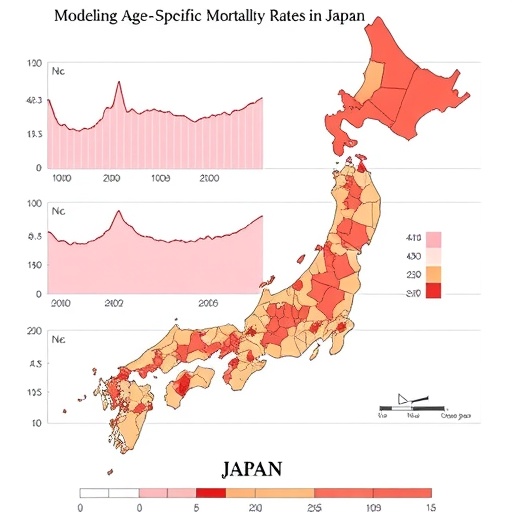In the evolving landscape of public health forecasting, a significant breakthrough has emerged from Japan, as reported in a recent study by researchers Chen and Nishino. Their innovative model focuses on predicting age-specific mortality rates at regional and prefectural levels, addressing a critical gap in mortality data precision that has long hampered effective health policy and intervention strategies. This work not only aims to refine mortality projections but also seeks to enhance the broader tapestry of demographic research in Japan, a nation facing unique challenges associated with an aging population.
Mortality forecasting has traditionally been an arduous task, characterized by a reliance on broad national averages that often mask regional disparities. Chen and Nishino’s model, however, delves deeper, capturing the nuanced variations that characterize different localities within Japan. The researchers have integrated various demographic, health, and socio-economic datasets, crafting a composite picture that reflects the realities faced by different age groups across Japan’s diverse regions. This model stands as a pivotal tool for public health officials seeking targeted interventions rather than generic, one-size-fits-all solutions.
At the core of this research lies the recognition that age is a critical factor influencing mortality rates. As populations age, the health challenges and risks they face become more pronounced, necessitating a tailored approach when it comes to health resource allocation. By forecasting age-specific mortality rates, the study equips policymakers with the insights needed to anticipate future health trends and allocate resources effectively. This model is particularly pertinent in Japan, where the demographic shifts toward an older population are both pronounced and rapid, presenting a significant challenge for its healthcare system.
Integrating advanced statistical methods and machine learning techniques, the study employs a sophisticated analytical framework that enhances the accuracy of mortality forecasts. The model’s ability to leverage vast datasets means it can accommodate a multitude of factors, from health behaviors to economic conditions, providing a nuanced analysis that traditional models cannot attain. This methodological advancement represents a significant leap forward in demographic research and public health planning, underscoring the importance of innovative analytical approaches in tackling contemporary challenges.
One of the key innovations of Chen and Nishino’s model is its focus on granularity. The researchers have meticulously calibrated their forecasts to reflect regional characteristics and demographic specifics, which allows for a more tailored understanding of mortality trends. This focuses on both urban and rural settings, taking into account the disparities between these environments. Such precision could prove transformative for health initiatives, enabling targeted actions that might significantly improve health outcomes across various populations.
Moreover, this model serves as a critical tool for understanding the impact of effective health interventions over time. As health policies are implemented to address chronic diseases, improve healthcare access, and promote healthier lifestyles, understanding their effect on age-specific mortality will be crucial. By providing a clear projection of mortality trends, Chen and Nishino’s model allows stakeholders to measure the efficacy of these initiatives and adjust them accordingly.
The implications of this research extend beyond Japan’s borders. As aging populations emerge globally, the methodologies employed in this study could serve as a template for other nations grappling with similar demographic transitions. The universal applicability of their findings underscores a critical point: aging is not only a local issue but a global challenge that necessitates a coordinated response across nations. Therefore, the findings of this research may inspire future studies worldwide, prompting similar efforts to refine mortality forecasting models.
Responding to the implications of localized mortality trends, the study advocates for ongoing data collection and continuous model refinement. As the researchers emphasize, mortality rates are not static; they are influenced by a multitude of ongoing factors, including environmental changes, technological advancements, and evolving health behaviors. Continuous monitoring and adaptation will be essential to keep pace with these changes, ensuring that forecasts remain relevant and actionable.
In conclusion, the development of this age-specific mortality forecasting model marks a critical advancement in public health research, particularly in the context of an aging Japan. By providing a clear, nuanced understanding of mortality trends at local levels, Chen and Nishino empower public health officials with the insights necessary to craft effective interventions tailored to the needs of specific populations. As the world grapples with the realities of aging demographics, this model serves as a beacon of innovation, illustrating the potential of data-driven approaches to revolutionize public health strategies.
In viewing the horizon of demographic research, one can anticipate that the insights gleaned from this study will extend far beyond the immediate context of aging in Japan. Rather, they will foster a broader dialogue on the importance of localized data in forecasting public health trends. While challenges remain, the groundwork laid by Chen and Nishino provides a promising pathway forward, paving the way for future research and innovations that prioritize accuracy, precision, and the unique needs of diverse populations.
As public health continues to evolve in the face of demographic shifts, the model developed by Chen and Nishino stands as a testament to the power of innovative research. Their commitment not only to enhancing forecasting methodologies but also to addressing the overarching challenges posed by an aging society underscores the vital role of research in shaping effective health policies and systems. This work, therefore, is not simply an academic exercise but a crucial contribution to the ongoing imperative of improving health outcomes for all.
Subject of Research: Mortality forecast model development at regional and prefectural levels in Japan.
Article Title: Development of a model for forecasting age-specific mortality rates at regional and prefectural levels in Japan.
Article References:
Chen, H., Nishino, H. Development of a model for forecasting age-specific mortality rates at regional and prefectural levels in Japan.
J Pop Research 42, 50 (2025). https://doi.org/10.1007/s12546-025-09400-2
Image Credits: AI Generated
DOI: 10.1007/s12546-025-09400-2
Keywords: mortality forecasting, age-specific rates, Japan, public health, demographic research, machine learning, health policy




